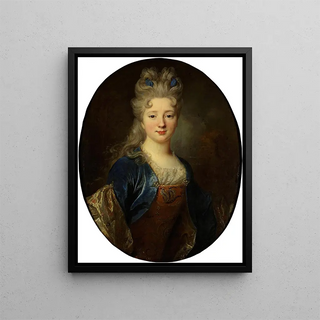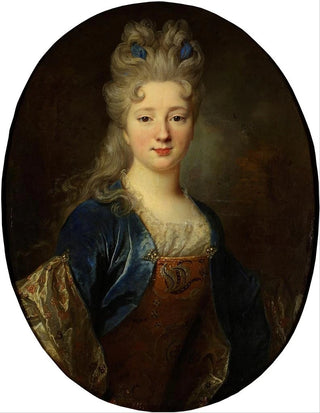Art print | Portrait of a woman - Nicolas de Largillière


View from behind

Frame (optional)
Nicolas de Largillière's "Portrait of a Woman," a hallmark of 18th-century art, perfectly embodies the elegance and refinement of its era. This painting, captivating through its harmonious composition and delicate color palette, immerses us in a universe where feminine beauty is celebrated with exquisite finesse. Through this portrait, Largillière succeeds in capturing not only the physical appearance of his subject but also an essence, a personality that transcends time. The grace of the features, the sparkle in the eyes, and the delicacy of the clothing testify to an exceptional craftsmanship that continues to delight art enthusiasts and history lovers alike.
Style and uniqueness of the work
Largillière's style is distinguished by its ability to blend realism and idealization. In "Portrait of a Woman," every detail is carefully crafted, from the luminous reflections in the hair to the textures of the fabrics. The artist uses light masterfully, creating interplay between shadows and highlights that bring his subject to life. The woman's pose, both natural and composed, conveys a quiet confidence, while the neutral background emphasizes the central figure. This stylistic choice draws attention to the face and hands, essential elements in conveying emotion. Largillière, through his approach, transcends the simple portrait to offer a true work of art that resonates with the viewer's soul.
The artist and his influence
Nicolas de Largillière, born in 1656, is one of the most renowned portraitists of his time. His career, spanning several decades, is marked by a stylistic evolution reflecting the changes in French society. Trained in the Flemish school, Largillière skillfully integrated various influences to develop a unique style, characterized by meticulous attention to detail and sensitivity to the psychology of his models. His impact on 18th-century portraiture is undeniable, inspiring many contemporary and future artists. By offering both an intimate and universal vision of his subjects, he helped establish portraiture as a major artistic genre, celebrating not only the elites

Matte finish

View from behind

Frame (optional)
Nicolas de Largillière's "Portrait of a Woman," a hallmark of 18th-century art, perfectly embodies the elegance and refinement of its era. This painting, captivating through its harmonious composition and delicate color palette, immerses us in a universe where feminine beauty is celebrated with exquisite finesse. Through this portrait, Largillière succeeds in capturing not only the physical appearance of his subject but also an essence, a personality that transcends time. The grace of the features, the sparkle in the eyes, and the delicacy of the clothing testify to an exceptional craftsmanship that continues to delight art enthusiasts and history lovers alike.
Style and uniqueness of the work
Largillière's style is distinguished by its ability to blend realism and idealization. In "Portrait of a Woman," every detail is carefully crafted, from the luminous reflections in the hair to the textures of the fabrics. The artist uses light masterfully, creating interplay between shadows and highlights that bring his subject to life. The woman's pose, both natural and composed, conveys a quiet confidence, while the neutral background emphasizes the central figure. This stylistic choice draws attention to the face and hands, essential elements in conveying emotion. Largillière, through his approach, transcends the simple portrait to offer a true work of art that resonates with the viewer's soul.
The artist and his influence
Nicolas de Largillière, born in 1656, is one of the most renowned portraitists of his time. His career, spanning several decades, is marked by a stylistic evolution reflecting the changes in French society. Trained in the Flemish school, Largillière skillfully integrated various influences to develop a unique style, characterized by meticulous attention to detail and sensitivity to the psychology of his models. His impact on 18th-century portraiture is undeniable, inspiring many contemporary and future artists. By offering both an intimate and universal vision of his subjects, he helped establish portraiture as a major artistic genre, celebrating not only the elites






